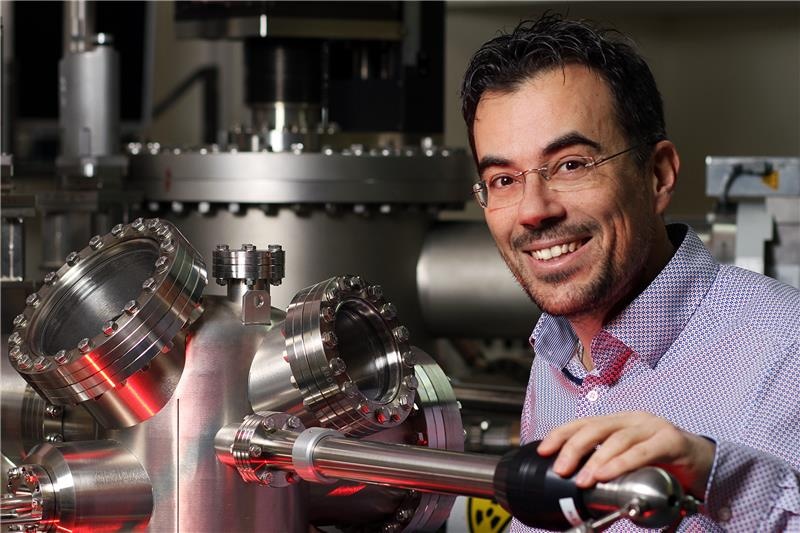Feb 5 2018
At airports, terahertz (THz) waves are typically used for checking luggage and passengers. They are also in huge demand in other areas, such as materials testing.
 Associate Professor Dr. Evangelos Papaioannou. (Image credit: TUK/Thomas Koziel)
Associate Professor Dr. Evangelos Papaioannou. (Image credit: TUK/Thomas Koziel)
At the Technische Universität Kaiserslautern (TUK), physicists have now devised a novel method for creating the THz waves. To achieve this, they apply a quantum magnetic current flow, the so-called spin current, in magnetic metal nanostructures. The material-saving and cost-effective technology could be used in a number of industrial applications. The study was reported in the leading scientific journal, Scientific Reports.
Invisible to the human eye, THz waves lie in the electromagnetic spectrum between infrared radiation and microwaves. Since these waves have low energy, they do not pose a major concern in terms of their impact on humans.
Currently, THz waves play a key role in communications and medical technology and they are also extensively used in materials testing. For instance, THz waves were used for inspecting the plastic insulation on space shuttles, but to generate these waves, powerful radiation sources such as emitters are required. This is often associated with high costs and energy consumption
Kaiserslautern researchers have now developed a highly efficient yet more cost-effective technique, in which a so-called spin current is used. This is similar to the electric current, where electrical charges, such as electrons, flow.
"A spin describes the intrinsic angular momentum of a quasiparticle, such as an electron," says Associate Professor Dr. Evangelos Papaioannou, who is a researcher with his own sub-group in the Magnetism Research Group headed by Professor Burkard Hillebrands in Department of Physics at TUK. "It forms the basis for all magnetic phenomena. Simply said, an electron rotates left or right around its axis like a spinning top."
Papaioannou’s research team has developed a unique nanostructure to apply this method. "It consists of a metal bilayer of magnetic iron and non-magnetic platinum," as the physicist elucidates the structure. "These are very thin layers that are only a few nanometers thick."
In order to produce the THz waves, a femtosecond laser is used that releases very short laser pulses. As a consequence, the following happens: "When the laser pulses hit the nanostructure they stimulate the electrons in the iron film, creating a spin current," says the Papaioannou. This current subsequently flows into the neighboring platinum layer and here a certain physical phenomenon comes into play – the so-called inverse Spin-Hall Effect.
In the case of platinum, this effect has been known for quite some time. It emerges because of the metal’s atomic structure. "The atomic nuclei of platinum deflect electrons with a left- and right-handed spin in opposite directions, which leads to the transformation of the spin current into an ultrafast transient charge current, which is then the source of terahertz waves”.
As an exclusive feature of the experimental setup, a tiny silicon lens is fixed to the structure. "We are bundling the waves", the Junior Professor continues. In this manner, the THz waves could be easily and efficiently translated to future applications.
In their newly published paper, the scientists have revealed, amongst other things, how the arrangement of materials and the thicknesses of layers should be optimally designed to generate the THz waves. In fact, the research field of THz spintronics technology has become a promising field.
For the first time, research colleagues in Berlin showed recently that spin current can generate the THz waves. The work of the Kaiserslautern research team demonstrates that a new method is now available to optimize the emitters so that they can achieve their maximum efficiency. This makes them more interesting and cost-effective for a wide range of application fields; e.g. for materials testing, security techniques, information technologies,and even for basic research.
The Papaioannou team is a part of the State Research Center for Optics and Material Sciences (OPTIMAS), which is funded by the state of Rhineland-Palatinate. Dr. G. Torosyan and Professor R. Beigang, who are experts in the THz field, also contributed to the study. The Deutsche Forschungsgemeinschaft within the scope of the Collaborative Research Center SPIN + X, as well as the Carl-Zeiss Foundation, supported the work.
The study was featured in the prestigious journal Scientific Reports: "Optimized Spintronic Terahertz Emitters Based on Epitaxial Grown Fe / Pt Layer Structures" DOI: 10.1038 / s41598-018-19432-9